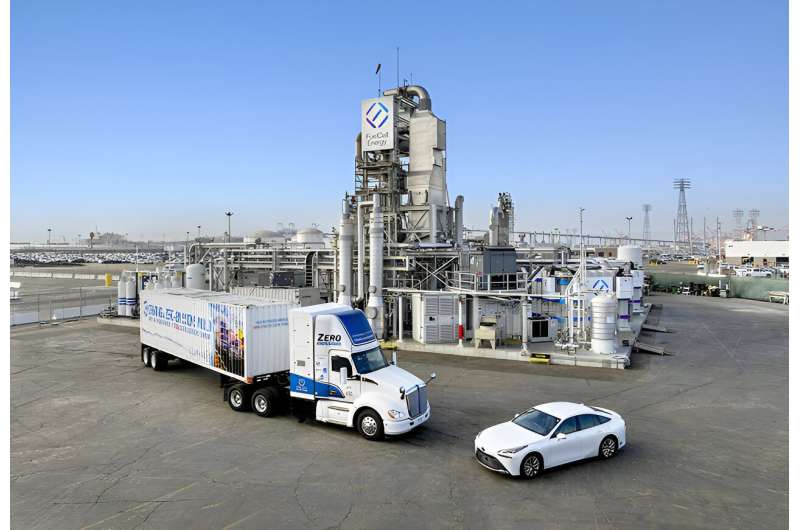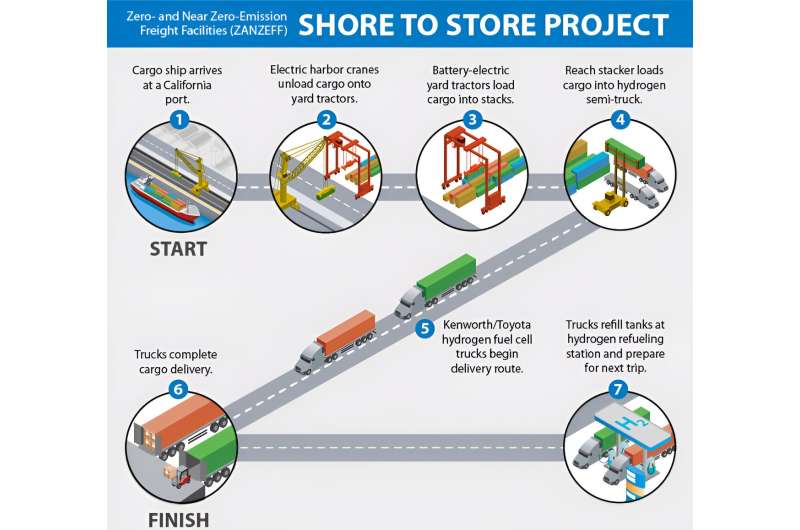
Vast amounts of worldwide emissions can be traced back to the supply chains that provide us with the goods we need. Some studies estimate that they generate up to two-thirds of global carbon emissions.
Now, researchers from the National Renewable Energy Laboratory (NREL), in collaboration with industry partners, have demonstrated the potential for a zero-tailpipe emissions supply chain—one that transports goods from the nation's busiest ports to their final destinations without producing vehicle emissions—all while using today's technology.
NREL analysis formed the backbone of the Port of Los Angeles' $82.5 million Zero- and Near-Zero-Emissions Freight Facilities Shore to Store project and final report, which brought together more than a dozen public and private sector partners for a 12-month demonstration of a net-zero-emissions supply chain that stretched across Southern California.
The California Air Resources Board and the Port of Los Angeles awarded the project funds, and the demonstration involved partners including Toyota Motor North America, Kenworth Truck Company, Shell, the Port of Los Angeles, and the Port of Hueneme.
The Shore to Store project, which used battery-electric cargo handling equipment, heavy-duty hydrogen-powered trucks, and hydrogen refueling stations to move goods from Southern California's ports to brick-and-mortar storefronts, provided one of the largest real-world demonstrations of clean goods movement to date. The project illustrated that multiple clean technologies, each powered by renewable energy and assigned to the area of best fit, can be combined to form a larger clean-energy system.
"The Shore to Store project showed that clean goods movement is not a distant dream," said NREL's Jason Lustbader, who leads NREL's advanced vehicles and charging infrastructure team and who served as the laboratory's project lead. "It is possible today, using today's technologies."
Anatomy of a decarbonized supply chain
To accurately model much of the goods movement throughout the United States, the Shore to Store clean supply chain demonstration began the moment container ships were lifted from cargo ships docked at port.
To illustrate the first link in the chain, the Port of Hueneme (POH), located in Southern California, added two electric-hybrid harbor cranes and supporting infrastructure into its operations. These zero-emissions cranes unloaded shipping containers from docked cargo ships.
Then, during the next link, POH used two battery-electric yard tractors powered by new charging infrastructure—the first zero-emissions equipment deployed at POH—to move cargo from ships to waiting trucks. The battery-electric yard tractors joined electric forklifts deployed at the nearby Toyota Logistics Services warehouse in demonstrating zero-emissions cargo movement within ports and storage facilities.
Next, a fleet of 10 Class 8 hydrogen fuel cell electric trucks shuttled cargo inland. The fleet was built in partnership by Kenworth Truck Company and Toyota Motor North America and operated by United Parcel Services (UPS), Toyota Logistics Services, Total Transportation Services Inc., and Southern Counties Express. Each truck refueled when needed at two newly constructed, high-capacity hydrogen fueling stations in Wilmington and Ontario, California.
The new fueling stations, built by Shell initially to support the demonstration project and now open to the public, have joined an existing heavy-duty refueling station operated by Shell at Toyota Logistics Services at the Port of Long Beach. Now, these three public stations form an integrated heavy-duty hydrogen fueling network that will continue to support the Los Angeles Basin, showcasing the potential for the United States to rapidly reduce transportation-related carbon emissions once appropriate infrastructure has been installed.

"We had a number of goals with the Shore to Store project," Lustbader said. "One was to demonstrate zero-emissions technologies in a real-world setting, so we could identify any barriers and how to overcome them.
"We also aimed to address some of the charging and refueling infrastructure challenges," Lustbader continued. "Now, we not only have new zero-emission freight vehicles in use but also functioning infrastructure to support the current and future generations of these technologies."
"We were honored to participate as infrastructure developers to make this hydrogen mobility supply chain project a reality and help our customers achieve their carbon neutrality goals," added Jared Leventhal, Shell's senior project manager for hydrogen mobility.
Analytics at scale
To understand the benefits of the advanced technologies deployed in the Shore to Store project, NREL researchers collected data on both the conventional equipment used in the demonstration and their clean-energy counterparts. Then, after 12 months of operation, researchers leveraged NREL's deep experience in advanced vehicle technologies and data analytics—and the laboratory's Fleet Energy, Research, and Data Insights (FleetREDI) data processing pipeline—to efficiently analyze a year's worth of operational data.
Their findings provided insights into the fuel savings and emissions reductions created by switching to low- and zero-emissions technologies across the supply chain.
First, researchers showed that the project's Class 8 hydrogen fuel cell trucks were capable of completing the rigorous duty cycles required from diesel trucks, while producing water as the only tailpipe emissions byproduct. And in contrast to battery-electric commercial trucks, which recharge their batteries over the course of several hours, refueling logs from the Shore to Store project show that hydrogen fuel cell trucks were capable of refueling in 15 to 20 minutes.
Researchers also demonstrated that the battery-electric yard tractors and forklifts matched the performance of their diesel counterparts, while providing far greater energy efficiency—and zero emissions.
On a larger scale, the project resulted in immediate, direct, localized emissions reductions in disadvantaged communities surrounding Southern California's ports and freight corridors. These reductions are critical, as the Los Angeles Basin is a non-attainment zone for criteria pollutants, meaning that the health of the region's residents is at risk of being seriously affected by excessive levels of air pollution.
In addition, Shore to Store expanded the use of zero-emissions equipment at the Ports of Los Angeles and Hueneme and created multiple new sources of hydrogen fuel throughout the region. Shell will continue to operate its hydrogen refueling stations, in part to support the fleet operators who will continue operating the project's fuel-cell trucks. Now, the Los Angeles Basin will have continued access to the new heavy-duty hydrogen fueling network.
"The Port of Los Angeles has been hard at work for two decades reducing air pollution from ships, trucks, trains, harbor craft, and cargo handling equipment," said Gene Seroka, executive director of the Port of Los Angeles. "The Shore to Store project provided invaluable lessons as we move toward decarbonizing the end-to-end supply chain. It's clear that there is much more work to do in the areas of accelerating technology and making it commercially available at scale. But as we look forward, we're grateful to our project partners for their efforts and to the NREL scientists who quantified its impact."
And as promising early deployments of hydrogen and battery-electric technologies improve, these innovative technologies can be adopted more widely for use in other heavy-duty applications—lowering emissions for generations to come.
More information:
The Port of Los Angeles Zero- and Near-Zero-Emission Freight Facilities "Shore to Store" Project.
ww2.arb.ca.gov/sites/default/f … s/2023-05/POLA-Final%20Report.pdf
Citation: Analysis shows snapshot of the clean supply chain of the future (2024, April 9) retrieved 9 April 2024 from https://techxplore.com/news/2024-04-analysis-snapshot-chain-future.html
This document is subject to copyright. Apart from any fair dealing for the purpose of private study or research, no part may be reproduced without the written permission. The content is provided for information purposes only.
